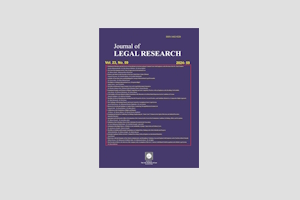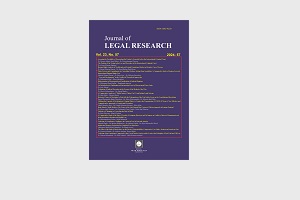Journal of
Legal Research
Number 9
Vol. V No. 1
Spring – Summer 2006
Managing Editor: Vahid Eshtiagh
Editor-in-Chief: Seyyed Ghasem Zamani
Contents
Articles
The Pros and Cons on Iran’s Nuclear Rights: From IAEA Board of Governors to UN Security Council
Nader Saed (Ph.D.)
Formation of Contract at Cyberspace
Mashallah Bana Niasari
Applicable Law in Air Transport: Study of Fokker 28 and C-130 Crashes
Mansoor Jabbari (Ph.D.)
Prohibition of Islamic Headscarf in Europe from Human Rights Law Perspective
Mahdi Haddadi
Reparation for Damages Caused to Iran by Illegal Attacks of USA to Oil Platforms
Seyed Hossein Sadat Maydani
Special Issue: Investment Law in Iran
Critical Analysis of Securities and Stock Exchange Act (2005) and It’s Effects on Iranian Capital Market
Hamid Reza Oloumi Yazdi (PH.D.)
Study of Trade Related Investment Measures Agreement (TRIMs) and Legal Effects of Iran Accession to it
Mohsen Sadeghi
Legal Aspects of Transferring Technology via Foreign Investment
Mostafa Elsan
Foreign Investment in Context of B.O.T. Contracts and the Iranian Foreign Investment Promotion and Protection Act
Maryam Ebrahimi
Investment Compensation Scheme in EU Law
Seyed Elhameddin Sharifi (Ph.D.)
Critique and Presentation
Expediency of the General Board of the Supreme Court in Referring Juvenile Delinquency to County Criminal Courts
Ali Khaleghi (Ph.D.)
Legal Context of 1696 Security Council Resolution on Iran’s Nuclear Programme
International & Public Law Research Group of SDIL
Universal Monitoring on Compliance with Human Rights: From UN Human Rights Commission to Council of Human Rights
Seyed Ghasem Zamani (Ph.D.)
Articles
The Pros and Cons on Iran’s Nuclear Rights:
From IAEA Board of Governors to UN Security Council
Nader Saed (Ph.D.)
Abstract:
In spite of three decades “Implementation of Safeguard Agreements in I.R.
of Iran” and three years concrete verifications by the IAEA, the issue was
informed to the UN Security Council in accordance with art. 12 of the
IAEA’s Statute. The Council by the statement of its President (29 March
2006), inter alia, calls on Iran to comply with the resolutions of the Board
of Governors and implement without delay all transparency or
confidence-building measures necessary to clarify the outstanding issues.
Nevertheless, emphasizing the importance of continuing its peaceful
nuclear programme for its supreme interests (development not military
nature), Iran refers to legal disputes between it and the IAEA as well as
three European countries on the implementation of INFCIR/214 (1974) as
a basis for their illegality i.e. they violated international nuclear rights of
Iran, as a NPT state party, to peaceful nuclear development.
This article analyzes the current process of Iran nuclear programme
from the Board of Governors to the Security Council, in particular, some
remarks on the interpretation of Iran nuclear rights in the light of
international nuclear law.
Formation of Contract at Cyberspace
Mashaallah Bana Niasari
Abstract:
The advent and common usage of Internet in the latest decades of 20th
century has made a virtual space, which is known as Cyberspace. This
virtual space have challenged many traditional concepts of private law; The
concepts such as domicile, consent and intention to create legal relations,
delivery and take delivery of subject matter of contract and so on are
required to redefinition. This article is trying to consider methods of
contracting at cyberspace and review the manner of determining of time
and place of such contracts.
Applicable Law in Air Transport: Study of Fokker 28 and
C-130 Crashes
Mansoor Jabbari (Ph.D.)
Abstract:
Iranian airlines industry has been faced with several incidents during the
last two decades. The two important cases are: Aseman Airlines (Fokker
28) and Iranian Military Aircraft incident (C-130 Hercules Aircraft). The
essential subject of this article is to study these two cases.
The article also reviews the applicable law concerning air transport. It
shows that the Convention for the Unification of Certain Rules Relating
to International Carriage by Air of 1929, known as the Warsaw
Convention, has gained acceptance throughout the world. It, in many
countries such as Iran, applies even in domestic air carriage.
Prohibition of Islamic Headscarf in Europe
from Human Rights Law Perspective
Mahdi Haddadi
Abstract:
The question of religious symbols has been widely discussed on the last
years in Europe. In the last few years, discussions have mainly focused on
the Islamic headscarf and whether women should be allowed to wear them
in education places.
From a human rights law perspective, international judicial or
quasi-judicial bodies have considered that the display of religious symbols
is a “manifestation” of religion or belief falling within article 18 (3) of
ICCPR and article 9 (2) of ECHR and therefore susceptible of limitation.
International human rights bodies not only have to be considered requires
of articles 18 and 9, but also take into account the other human rights
aspects that may be at stake in the situation concerned.
Reparation for Damages Caused to Iran by Illegal Attacks of
USA to Oil Platforms
Seyed Hossein Sadat Maydani
Abstract:
On 6 November 2003 the International Court of Justice delivered its
judgment in the case concerning oil platforms between Iran and USA. The
case arose out of forcible action by US naval forces in the Persian Gulf
against certain Iranian oil platforms in October 1987 and April 1988. After
examination of the case the court finally concluded that the action carried
out by United States forces against Iranian oil installation couldn’t be
justified under 1955 treaty as being measures necessary to protect the
essential security interests of the United States, since those actions
constituted recourse to armed force not qualifying, under international law
on the question, as acts of self-defence. However the court found that the
claim of the Islamic Republic of Iran for reparation couldn’t be upheld.
This article is confined to assessing the legal and logical relationships
between breach of international law and duty to reparation and legal
mechanisms for enforcement of these ICJ’s findings.
Critical Analysis of Securities and Stock Exchange Act (2005)
and It’s Effects on Iranian Capital Market
Hamid Reza Oloumi Yazdi (PH.D.)
This paper is intended to look at the changes made in the legal structure
of the Iranian capital market, due to the new legislation on securities and
stock exchange enacted in late 2005 in the Islamic Republic of Iran, to
replace the law with almost a similar title, but enacted some 40 years ago.
Hence, it will take a comparative approach between these two laws to
exhibit advantages and innovations of the new Act, as well as its
ambiguities and gaps. The new law is a step forward to a professional,
transparent, and self regulated capital market. However, some issues are
not clearly dealt with in this Act, such as legal structure of the “funds” and
“shares basket”. Moreover, the stand of foreign investment in this market
and the protections that may receive are not clear enough.
Study of Trade Related Investment Measures Agreement
(TRIMs) and Legal Effects of Iran Accession to it
Mohsen Sadeghi
Agreement on Trade Related Investment Measures (TRIMs) as one of the
WTO Agreements, prevents the member states from the restrictive legal,
administrative and economic measures against foreign investors and from
giving special advantages to domestic investors after entrance of foreign
invests. Therefore, WTO members cannot bind foreign investors to provide
a part of their labor force and equipment from domestic section. In
addition, they cannot provide quantitative restrictions on export and
import.
In Iranian legal system, there are many regulations contrary to
principles and rules of TRIMs; therefore, the legislator must eliminate or
amend these regulations for accession to WTO.
In this article, we study TRIMs principles, contrastable regulations of
Iranian Law and suitable solutions.
Legal Aspects of Transferring Technology
via Foreign Investment
Mostafa Elsan
Foreign investment contracts are prevalent methods for transfer of
technologies. Unless in the case of direct purchasing of foreign technology
and its intellectual property rights, developed States have preferred
financial and technical investing for excessive profits, economic control and
political influence. In other perspective, for developing countries, linking
between foreign investments likewise technologies in one contract is
exclusive available chance for improvement, which provided to drafting
technology transfer mechanisms with consideration to potencies of
national economy and a sustainable plan for future of national and
international business. In this paper, after analyzing the relationships
between investment and technology transfer, limitations and restrictions of
technology transfer via investment has discussed, too.
Foreign Investment in Context of B.O.T. Contracts and the
Iranian Foreign Investment Promotion and Protection Act
Maryam Ebrahimi
Foreign investment which is an important economic phenomenon, involves
transfer of tangible or intangible assets from one country into another for
the purpose of their use in that country to generate wealth under the total
or partial control of the owner of the assets.
The Islamic Republic of Iran as a developing country has increasingly
need to promotion of foreign investment. The Iranian foreign investment
promotion and protection act was adopted by the parliament in 2002.
B.O.T. (Build, Operate, Transfer) contracts regarded as one of the
important devices for promotion and protection of foreign investment in
the Iranian Law. The present article reviews the B.O.T. contracts in the
Iranian foreign investment promotion and protection Act.
Investment Compensation Scheme in EU Law
Seyed Elhameddin Sharifi (Ph.D.)
Investors protection is one of the major objectives of EU directives on
Investment services and capital adequacy to promote fair, transparent,
efficient and integrate financial markets.
Whereas, the regulations and supervision to be insufficient to protect
investors in all circumstances, particulalry where acts of fraud are
committed. Thus the European parliament and council enacted a
protection directive 97/9/EC, Known as the Investor Compensation scheme
Directive. This directive provide a harmonised minimum level of
compensation at EU 2000, at least for small invertors in the event often
investment firm being unable to meet its obligation to its investor clients.
The scope of protection covers funds, securities, derivatives and money
market instruments. However, the directive dose not safeguards claims
resulting from unsound investment advice.





